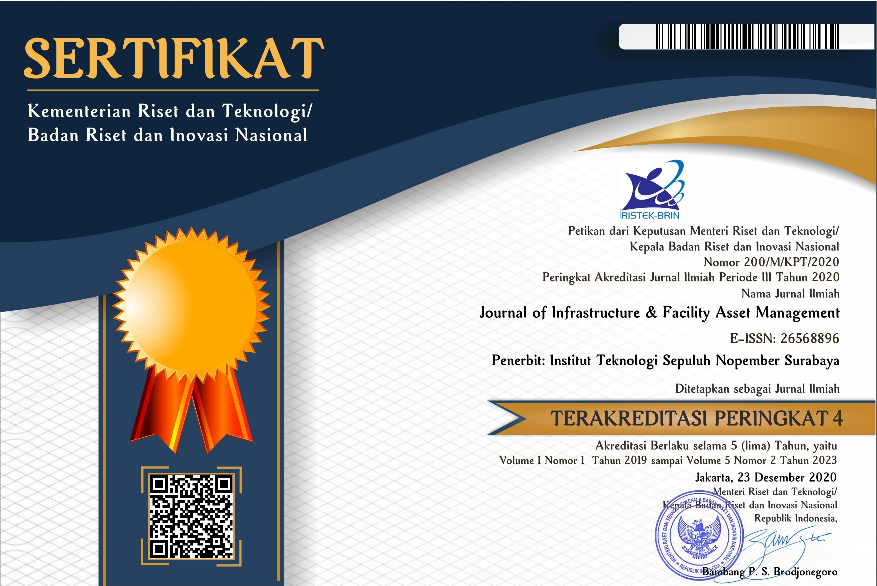Development of Cell Transmission Model for Traffic Signal Coordination
Abstract
This research aims to develop a macroscopic traffic model to estimate delay at signalized intersections by considering queue forming and dissipation in the presence of pre-timed signal. Cell Transmission Model (CTM) was set up with basic traffic input parameters to estimate delay and level of service (LOS) and the results are compared to computational analysis run by SIDRA (Signalized and Unsignalized Intersection Design and Research Aid) software. To optimize the traffic flow condition, traffic signal coordination is carried. It was found that optimized traffic signal setting reduces delay by 25.5% and 17% in Intersection A and Intersection B after a second run by CTM.
Full Text:
PDFReferences
Akcelik, R. (1996). Signalized & Unsignalized Intersection Design & Research AID (SIDRA). Transport Research Ltd, Australia.
Akcelik, R. (2014). “A new lane-based model for platoon patterns at closely-spaced signalized intersections”. in 26th ARRB Conference. Sydney, Australia.
Astarita, V. (2002). “Node and link models for network traffic flow simulation”. Mathematical and Computer Modelling, Vol. 35, No. 5-6, pp. 643-56.
Balijepalli, N., Ngoduy, D. & Watling, D. (2014). “The two-regime transmission model for network loading in dynamic traffic assignment problems”. Transportmetrica A: Transport Science, Vol. 10, No. 7, pp. 563-84.
Daganzo, C.F. (1994). “The cell transmission model: A dynamic representation of highway traffic consistent with the hydrodynamic theory”. Transportation Research Part B: Methodological, Vol. 28, No. 4, pp. 269-87.
Drew, D.R. (1968). Traffic flow theory and control. McGraw-Hill. New York.
Girianna, M. & Benekohal, R.F. (2004) “Using genetic algorithms to design signal coordination for oversaturated networks”. Journal of Intelligent Transportation Systems, Vol. 8, No. 2, pp. 117-29.
Husch, D. & Albeck, J. (2003). Synchro 6: Traffic signal software, user guide. Trafficware Limited. Albany, California.
Knoop, V., van Zuylen, H. & Hoogendoorn, S. (2008). “The influence of spillback modelling when assessing consequences of blockings in a road network”. EJTIR, Vol. 4, No. 8, pp. 287-300.
Lighthill, M.J. & Whitham, G.B. (1955). “On kinematic waves. II. A theory of traffic flow on long crowded roads”. in Proceedings of the Royal Society of London A: Mathematical, Physical and Engineering Sciences, Vol. 229, pp. 317-45.
Lo, H.K. (1999). “A novel traffic signal control formulation”. Transportation Research Part A: Policy and Practice, Vol. 33, No. 6, pp. 433-48.
Lo, H.K. (2001). “A cell-based traffic control formulation: strategies and benefits of dynamic timing plans”. Transportation Science, Vol. 35, No. 2, pp. 148-64.
Mardiati, R., Ismail, N. & Faroqi, A. (2014). “Review of Microscopic Model for Traffic Flow”. ARPN Journal of Engineering and Applied Sciences, Vol. 9, No. 10.
Mathew, T.V. (2014). “Transportation Systems Engineering”. Cell Transmission Models. IIT Bombay.
Nyantakyi, E.K., Owusu, P.A. & Borkloe, J.K. (2014). “Methods for the Assessment of Performance Indication Measures at Amakom Intersection and their Application in Micro Simulation Modeling”. International Journal for Traffic and Transport Engineering, Vol. 4, No. 1, pp. 35-51.
Richards, P..I (1956). “Shock waves on the highway”. Operations Research, Vol. 4, No. 1, pp. 42-51.
Smit, R. (2006). “An examination of congestion in road traffic emission models and their application to urban road networks”. Phd Report.
Sunkari, S. (2004). “The benefits of retiming traffic signals”. Institute of Transportation Engineers. ITE Journal, Vol. 74, No. 4, p. 26.
Suprayitno, H. & Soemitro, R.A.A. (2018). “Preliminary Reflexion on Basic Principle of Infrastructure Asset Management”. Jurnal Manajemen Aset Infrastruktur & Fasilitas, Vol. 2, No. 1, Maret 2018, Hal. : 1-10.
Wallace, C.E., Courage, K., Reaves, D., Schoene, G. & Euler, G. (1984). TRANSYT-7F user's manual.
Wang, J., Lu, H. & Peng, H. (2008). “System Dynamics Model of Urban Transportation System and Its Application”. Journal of Transportation Systems Engineering and Information Technology, Vol. 8, No. 3, pp. 83-9.
Wang, P. (2010). Conditional cell transmission model for two-way arterials in oversaturated conditions, Vol. 71.
Wang, P., Jones, L., Yang, Q. & Gurupackiam, S. (2013). “Cell transmission model based traffic signal timing in oversaturated conditions”. Journal of Central South University, Vol. 20, No. 4, pp. 1129-36.
Wu, W., Shen, L., Jin, W. & Liu, R. (2015). “Density-based mixed platoon dispersion modelling with truncated mixed Gaussian distribution of speed”. Transportmetrica B: transport dynamics, Vol. 3, No. 2, pp. 114-30.
Zhu, F., Lo, H.K. & Lin, H-Z. (2013). “Delay and emissions modelling for signalised intersections”. Transportmetrica B: Ttransport Dynamics, Vol. 1, No. 2, pp. 111-35.
DOI: http://dx.doi.org/10.12962%2Fjifam.v2i1.6905
Refbacks
- There are currently no refbacks.
Visitor :
Flag Counter

Journal Of Infrastructure & Facility Asset Management by Institut Teknologi Sepuluh Nopember is licensed under a Creative Commons Attribution-ShareAlike 4.0 International License.





